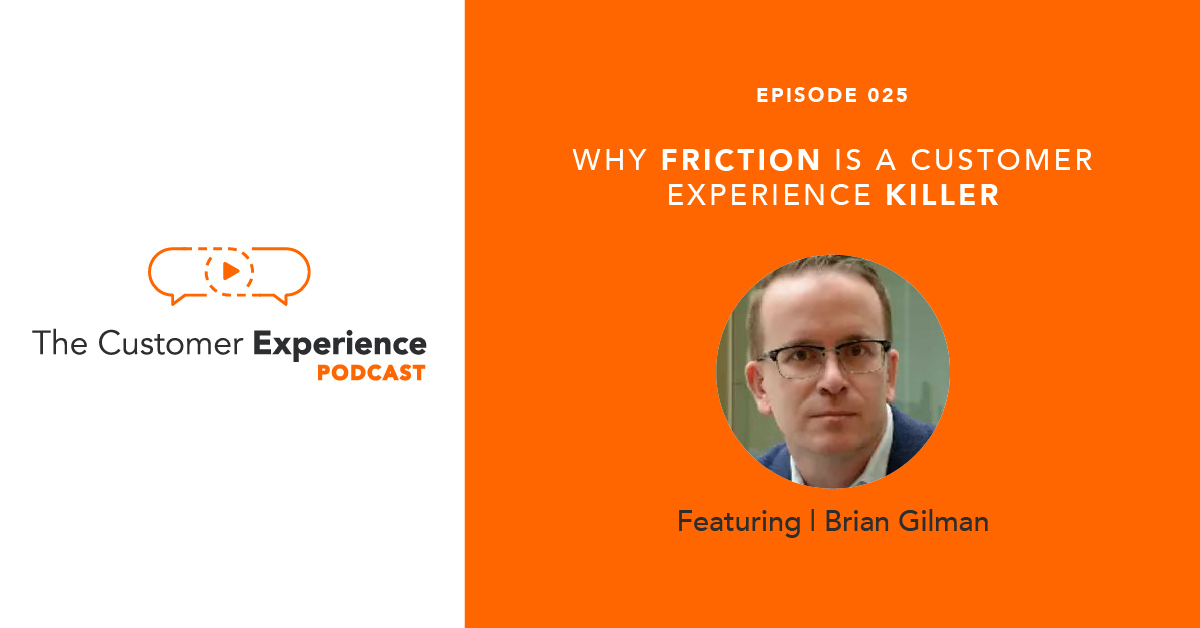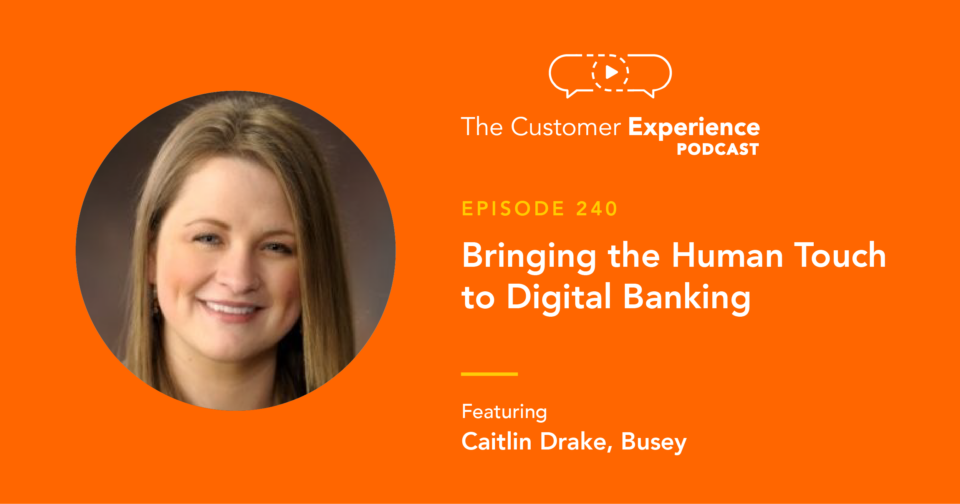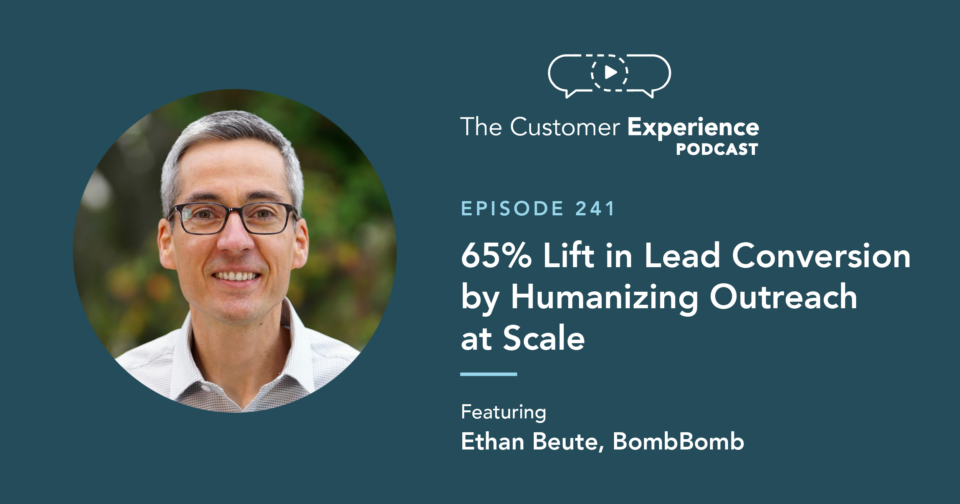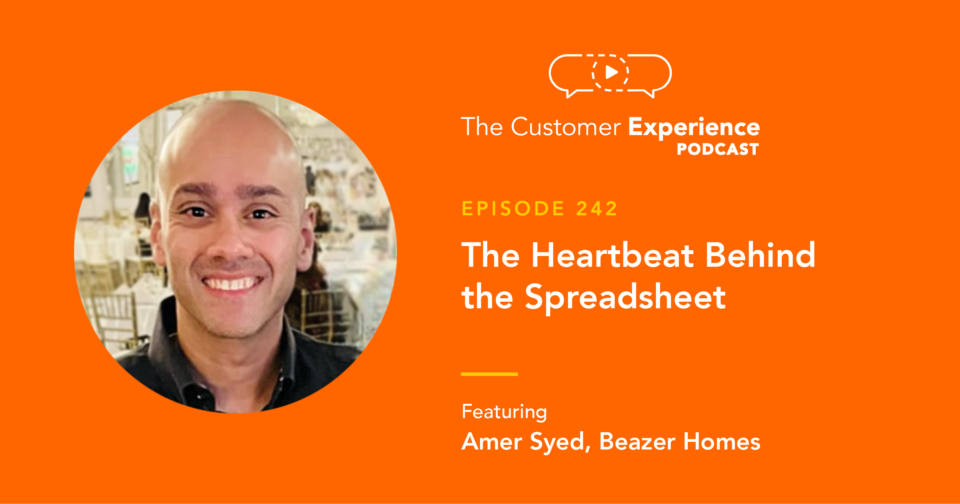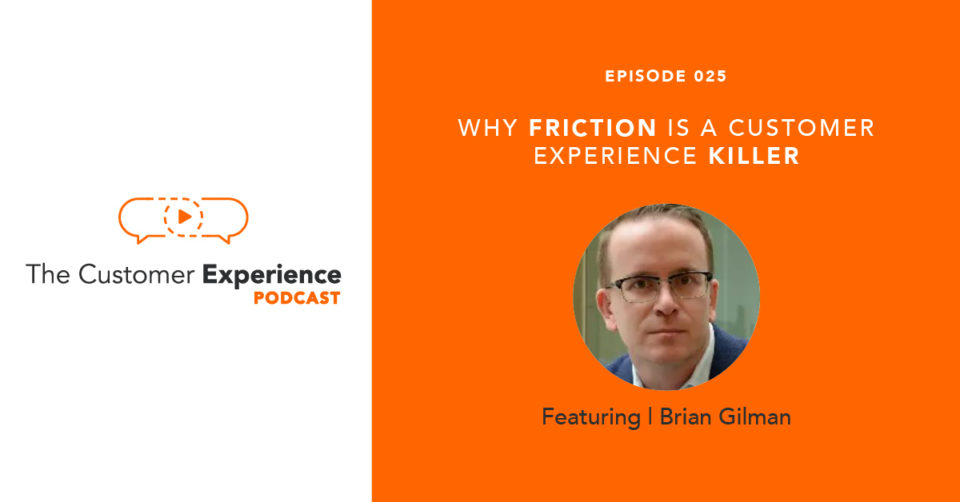
Listen to “25. Why Friction is a Customer Experience Killer w/ Brian Gilman” on Spreaker.
Apple Podcasts | Google Podcasts | Stitcher | Spotify
Nothing kills a customer experience today quite like friction.
So says Brian Gilman, Vice President of Product Marketing at Vonage.
Brian has decades of experience in product marketing – and he was kind enough to spend a half hour with me to share insights into solution selling, competitive intelligence, customer experience, and more.
Among the topics he takes on:
- The shift in control away from businesses and toward customers
- The difference between marketing products and marketing solutions
- How product integrations help your customers and your employees
- Strategies for selling layered and verticalized solutions
- The roles of channels, control, and context in competitive environments
- How video and artificial intelligence can reduce friction
I know you’ll enjoy several valuable takeaways from this thoughtful conversation. Honestly, you may want to listen to this one twice (seriously).
Why Friction Is A Customer Experience Killer
To hear this episode and many more like it, subscribe to The Customer Experience Podcast in Apple Podcasts by clicking here.
Don’t use Apple for your podcasts? No problem! Here are more listening options …
Hear the entire conversation with Brian Gilman right here …
Listen to “25. Why Friction is a Customer Experience Killer w/ Brian Gilman” on Spreaker.
Friction as a Killer and AI and Machine Learning as Solutions
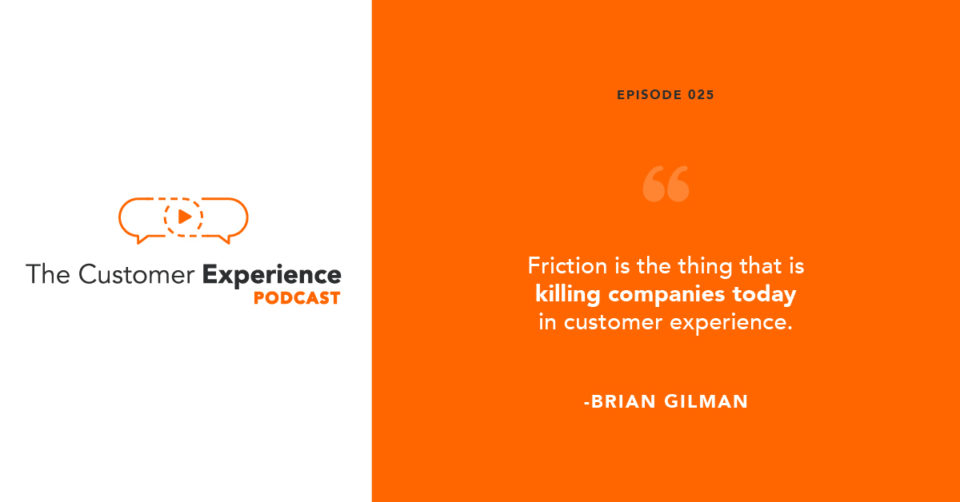
Near the start of our time together, Brian used a key word … friction. It’s a stand-in for any point of confusion, frustration, or anything else that slows down or creates pain for the customer.
Think about your own experience navigating a physical space or a phone menu. The handoffs. The delays. The implication that you arrived at a point through your own error, rather than a mistake or inefficiency of the company. This is all friction.
And it’s what kills customer experience. So we need to evolve, because the competitive landscape is changing quickly. Entire companies have been built on “frictionless” experiences – and several have multi-billion dollar valuations.
As Brian says in the video clip embedded below: “If you can remove that layer of friction by having better intelligence and more machine learning to get the right customer to the appropriate agent, you win.”
What is the Role of Product in the Customer Experience?
As the Vice President of Product Marketing at Vonage, Brian jokes that he must have one of the the worst-named roles of anyone who’s been on The Customer Experience Podcast.
Why? Because when you look at today’s technology, it’s mostly in the cloud, which makes “product” a somewhat antiquated term. Instead, he sees many products as “platforms” and “solutions.”
Regardless, we’ll use the term product for the sake of convenience – and its relationship to customer experience begs two questions:
- 1) How easily can I deploy the product and start getting value?
- 2) How interoperable is the product within my network and tech stack?
As companies grow, they bring in Salesforce, Sugar CRM, or even G Suite. You can now start to take your product and hook it into these other productivity platforms through APIs (learn about BombBomb’s APIs here and BombBomb’s integrations here).
For every dollar a customer spends on a communication platform like Vonage, they’re probably spending 5x to 10x that amount on these other productivity applications. It’s all part of “digital transformation” — another term people like to throw around.
Your product has to interoperate between these to positively impact customer experience.
Here’s what that means:
They’ve spent five times what they would spend on a communications platform on Salesforce. They’re training, onboarding, and implementing appropriately, but every time a salesperson has to enter a phone number, they’re doing it by hand. On the inbound side, when they get a call they have to go look up that person.
From a productivity perspective on the employee side, it’s incredibly inefficient.
Having your product be able to seamlessly interact with these other apps to drive intelligent interactions is better for employees and creates a better customer experience. Customers suffer fewer awkward snags, slowdowns, handoffs, and wait times.
Brian explains in this video clip from the episode …
What’s the Primary Role of Competitive/Market Intelligence?
In every company Brian’s served, competitive intelligence has been one of the more difficult challenges he’s had to solve. No matter how much you do, it will never be enough to make most teams happy. “You give eight, they want twelve,” Brian warns. “You do twelve, they want twenty.”
Since every marketing teams operates with finite resources, Brian’s team has agreed upon a couple of things:
The core competitors they’re building scripting against.
Depending on the competitor, they’ve agreed to keep a certain cadence of updates. It’s manageable.
Deploying a competitive intelligence platform.
They do the heavy lifting of putting in information, but there are some things the platform can automate. For example, they can put page links into the platform, and anytime a competitor changes something on their pricing page Brian gets an alert.
This helps them adjust to the market faster. You’d think that quarterly assessments would be enough, but it’s not in their market. Anytime you miss something, you’re always going to get called on it.
Here’s some of what Brian shared on CI …
Why Is Video Such a Valuable Part of Human Customer Interaction?
Video does a lot for the emotional side of customer interactions. It connects people.
Brian used to work with a credit union that had a problem: spikes of foot traffic in their branches during certain time periods. If you were a customer, you would go into the branch and speak to someone behind the desk, likely a year or two removed from college. You would ask him or her a question about a mortgage, and they’d have to and you off to a 1-800 number because they didn’t have an answer.
It’s a cold experience. And every handoff is a point of friciton for the customer and potential missed opportunity for the company.
The customer is now equally as likely to call Chase, Bank of America, or someone else down the street.
So, the credit union started putting kiosks in the branch with video capability. Face to face is always preferable; there are proven studies about the effectiveness on close rate of having face-to-face interactions (we cite some of it in our book, Rehumanize Your Business).
In decending order of connection: from in person, to video, to voice. If in person doesn’t make sense or isn’t scalable, having a ready video connection is the next best thing.
With video, you get immediate emotional feedback. You can read body language. You can physically gauge the nuances of a conversation.
These days, video is even available in things like field services. When someone’s internet is down, you don’t necessarily want to deploy a truck that may take a week to arrive. Now, some customers can use their camera, take a look at a router, and have you tell them a wire is out of place.
If I can’t verbalize something to you, because I’m not technical, video can solve the problem. You’re solving for issues that are emotionally distressing.
Which is another way of saying, you’re banishing the friction between where the customer is right now and where he or she wants to be.
Check out this short clip to hear Brian explain the role of synchronous video for better customer experience …
This post is based on an interview with Brian Gilman, VP of Product Marketing at Vonage.
Want to hear more CX conversations like this one? Subscribe to The Customer Experience Podcast (click right here). When you click through, take a minute to rate or review the podcast – it’s extremely helpful!
If you don’t listen to podcasts in Apple Podcasts, check out The Customer Experience Podcast on Spotify, Google Podcasts, or Stitcher.
More from The Customer Experience Podcast
Available Right Now:
- “Balancing Automation, AI, and Human Relationships” with Samantha Stone (founder and CMO, Marketing Advisory Network)
- “You Have 100 Days to Create or Lose a Lifelong Customer” with Joey Coleman (author, Never Lose a Customer Again)
- “Customer Experience Starts Before There’s a Customer” with Rachel Ostrander (Director of Runner Experience, Brooks Running)
- Explore your options by clicking here
Coming Soon:
- Chief Education Evangelist Jaime Casap (Google)
- Marketing leader and brand strategist Kristy Krueger (Revel Health)
- Intellectual property and marketing law attorney Sharon Toerek (Legal+Creative)
Email Ethan(at)BombBomb(dot)com with any feedback on the show or guest recommendations.
Learn To Implement Video The Right Way
Brian articulates succinctly the value of synchronous video for customer experience.
At BombBomb, we articulate clearly the value of asyncrhonous video for customer experience.
Learn how to implement video in your business from the Amazon #1 bestseller in Business Sales, Business Communication, and Customer Relations, the 800-CEO-Read #1 bestseller in its opening week of release, and a Barnes & Noble bestseller it its opening week of release.

